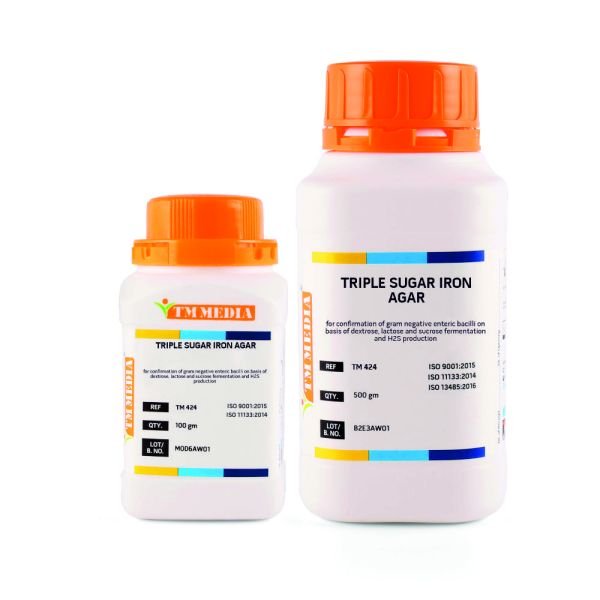Free Shipping for all Order of ₹500
COD payment is available.
Triple Sugar Iron Agar
INTENDED USE
For identification of gram-negative enteric bacilli on the basis of dextrose, lactose and sucrose fermentation and H2S production.
Shop for ₹499 and get flat ₹100 OFF only for new users
MLSIGNUP100
Expiring in 1days 2hr12min47secPRODUCT SUMMARY AND EXPLANATION
Triple Sugar Iron Agar was originally proposed by Sulkin and Willett and modified by Hajna for identifying Enterobacteriaceae. This medium complies with the recommendation of Indian Pharmacopoeia for the identification of Gram-negative bacilli.
Triple Sugar Iron Agar (TSI Agar) is a differential medium that isolates and identifies the members of Enterobacteriaceae family and other gram-negative enteric bacilli based on the capacity to ferment sugars and give a reaction for hydrogen sulphide (H₂S). The medium is extensively applied in clinical diagnosis, water quality testing, drug quality control, and food microbiology.
The medium has three carbohydrates—sucrose, lactose, and glucose—and phenol red for pH indicator, ferrous sulphate to identify hydrogen sulphide, and peptones to provide a medium for bacterial growth. Differential fermentation of the three sugars results in diagnostic colour change in the slant and butt areas of the medium, enabling unambiguous identification of patterns of fermentation. Glucose fermenters will generally present an acid butt (yellow) with an alkaline slant (red) when glucose is depleted, but lactose/sucrose fermenters produce an acid slant and butt.
Gas production is seen as bubbles, cracking, or agar displacement. Hydrogen sulphide production is seen as black precipitate on reaction of H₂S with ferrous sulphate. They are quick and specific tests for the identification of pathogens like Salmonella, Shigella, Escherichia coli, Proteus, and Klebsiella.
TSI agar is streaked in a slant in test tubes, which allows for the presence of aerobic and anaerobic growth conditions simultaneously in one test tube. The test tubes are incubated at 35–37°C for 18–24 hours after being inoculated by stabbing the butt and streaking the slant. Physical reactions and colour changes seen after incubation are interpreted.
PRINCIPLE
Peptone, yeast extract and beef extract provide nitrogenous compounds sulphur, trace elements and vitamin B complex etc. Sodium chloride maintains osmotic equilibrium. Lactose, sucrose and dextrose monohydrate are the fermentable carbohydrates. Sodium thiosulphate and ferric or ferrous ions make H2S indicator system. Sodium thiosulphate is also an inactivator of halogen and can minimize its toxicity in the testing sample, if any during microbial limit tests. Phenol red is the pH indicator.
QUALITY CONTROL SPECIFICATIONS
Appearance of Powder : Light yellow to pink homogeneous free flowing powder.
Appearance of prepared medium : Pinkish red coloured clear to slightly opalescent gel forms in Petri plates.
pH (at 25°C) : 7.4±0.2
COMPOSITION
| Ingredients | Gms / Ltr |
| Beef extract | 3.000 |
| Peptone | 20.000 |
| Yeast extract | 3.000 |
| Lactose | 10.000 |
| Sucrose | 10.000 |
| Dextrose monohydrate | 1.000 |
| Ferrous sulphate | 0.200 |
| Sodium chloride | 5.000 |
| Sodium thiosulphate | 0.300 |
- Dissolve 64.42 grams in 1000 ml distilled water.
- Heat to boiling to dissolve the medium completely.
- Mix well and distribute in test tubes.
- Sterilize by autoclaving at 15 lbs pressure (115°C) for 30 minutes or as per validated cycle. Allow the medium to set in sloped form with a butt about 2.5cm long.
This medium is of crucial use in the initial detection of enteric bacteria from clinical specimens, food safety testing, and potable water quality analysis of drinking water. The medium is cost-effective, easy to read, and of diagnostic grade, hence the benchmark in bacteriological labs across the globe.



The information below is required for social login
Sign In
Create New Account